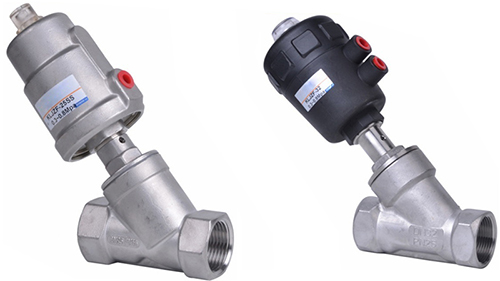Angle Seat Valve Basics: Components, Working Principle and Application
Angle seat valves are 2-way, 2-position pneumatic piston valves. The piston pneumatic actuator provides linear motion to lift the seal from its seat. Because the seat is positioned at an angle, flow obstruction is minimal in the open position, resulting in excellent flow and low pressure losses. They are used to regulate the flow of liquids, gases, vapors, vacuum and even corrosive fluids. Angle seat valves can operate in high temperature and high viscosity media even at zero differential pressure. Rugged design makes these angle seat valves a best choice for harsh applications, and they have a very high cycle life.

What are the Components of Pneumatic Angle Seat Valve?
The body of the angle seat valve is usually cast or forged in one piece. A plug is attached to the end of the piston, which is located on the seat. The piston is designed to retract further from the seat to provide maximum flow. They can be normally closed (NC), normally open (NO), or double-acting. Piston actuators have threaded ports to allow direct installation of solenoid valves. Typically, the actuator can be rotated 360° to achieve optimal air and wire placement in a narrow position. Valve body is generally made of stainless steel. Connection types include threaded, clamped, welded or flanged.
Angle Seat Valve Working Principle
Angle seat valves are operated by air supply. Normally closed valves usually close the valve under no pressure and use a spring to return the valve to rest. Normally open valve openings remain open unless air pressure closes them. Double acting angle seat valves can be used to handle two-way flow. These valves have no spring and rely on air supply to locate the valve. These configurations affect the valve pressure rating. Up and down flow will reduce the water hammer effect, but will typically reduce the valve's maximum operating pressure by 50%. However, installing a strong return spring will help increase the working pressure, but larger actuators are required to overcome this increased spring strength. Full working pressure can be achieved through flow over the seat and the water hammer can be reduced by limiting the flow of compressed air supply.
Angle Seat Valve Application
Angle seat valves are used to provide multiple operating cycles in demanding applications such as steam, water and corrosive media. They are well suited for vacuum applications and can be used in fast-acting applications with up to 1,000 cycles per hour and a life expectancy of more than 10 million cycles. They are used in many industries, including food and beverage, chemicals, oil, gas, water, sewage and so on.
ATO.com provides 1/2 inch, 3/4 inch, 1 inch, 1-1/2 inch, 1-1/4 inch, 2 inch, 2-1/2 inch, 3 inch and 4 inch thread port pneumatic angle seat valve for you to choose from, stainless steel and polyamide pneumatic actuator available. Buy for your applications now!

